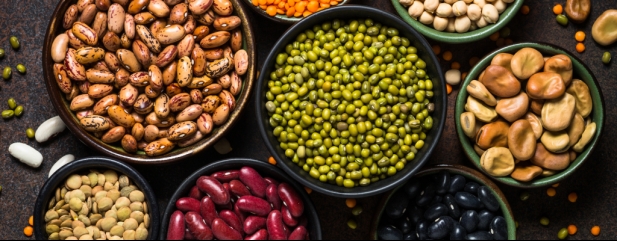Archived article
Please note that tax, investment, pension and ISA rules can change and the information and any views contained in this article may now be inaccurate.
Why commodity prices seem to be full of beans

One of the fiercest debates of 2020 from an investment perspective remains whether inflation, stagflation or deflation will be one result of the pandemic and some of the policies deployed in response to it.
No-one knows the ultimate outcome – not even central bankers, who, if they did, would not be still using and tweaking policies that were called unorthodox and exceptional when they were launched over a decade ago in further efforts to generate the inflation they crave.
All investors can do is watch out for possible signs that inflation or deflation is on the way and keep an open mind.
Judging by yields of 0.38% on the US five-year Treasury bond and 0.02% on the UK five-year Gilt, bond markets take the view that deflation remains the danger. That suggests the next few years will be like the last 10 or so – namely low growth, low inflation and low interest rates.
Such an environment has a proved fertile breeding ground for long-duration assets such as technology, biotechnology and ‘growth’ stocks, as well as bonds, but harder work for shorter-duration assets such as cyclical or ‘value’ equities and commodities.
Yet not everyone is convinced. Five-year forward inflation expectations are hovering around 1.8% and if that proves right then developed market government bonds offer relatively little protection.
Inflation expectations are not currently rising but it will be interesting to see if they are influenced by commodity prices, which are ticking higher once more.
Price movements
Even a casual glance at the media will gave a flavour of the action in commodity markets. Copper trades above $7,000 a tonne and after a 60%-plus rally since spring trades at its highest mark for two-and-a-half years.
Iron ore is pushing toward $130 a tonne and its best mark for at least five years. Soybeans stand at a four-and-half-year high and corn prices are at the highest level since July 2019. Cocoa stands at a nine-month high.
The net result is that the Bloomberg Commodity index is nearing the peak of 2018 and thus bearing down on levels last seen before that in 2014. 
The question now is whether this is a trend and whether rising raw materials costs for companies and rising food costs for consumers will lead to inflation, should the former raise prices to protect profit margins and the latter demand pay rises to help them meet the higher cost of living.
In such an uncertain economic environment as the current one, few firms or consumers may be willing to chance their arm, it must be said. But in a post-vaccine world the picture could look very different, emboldening both.
It is tempting to argue that the increase in copper and iron ore prices is one indication that an economic upturn is on the way, thanks to fiscal and monetary stimulus programmes the world over and expectations that a vaccine is on the way and 2021 will be a better place all round.
The food price increases may not be quite so conclusive and could just as easily be the result of the La Niña weather pattern which is in evidence this year. This complex meteorological feature occurs relatively rarely – America’s National Oceanic and Atmospheric Administration says this is just the seventh incidence since 1970 – but it can lead to below-average rainfall in Peru and Chile, East Africa and southwestern America and bring storms and floods to Brazil, Southern Africa, Australia and Asia.
Investors have enough imponderables to face without having to think about the weather. Second-guessing such near-term patterns really would be a mug’s game especially since inflation in America accelerated during only two of the last six La Niña patterns, even if it did so five times in the UK.
Major shift
Nevertheless, it should be informative to see how the Bloomberg Commodity index fares. Having massively outperformed equities in the first decade of this millennium, commodities were huge laggards in the second.
Whether we are on the cusp of one of those once-in-a-decade shifts that has huge ramifications for asset allocation and equity and fund selection remains to be seen. But commodity prices do not, for the moment at least, share the bond market’s conviction that the next five to 10 years are going to see the same economic backcloth as the last five to 10.
Important information:
These articles are provided by Shares magazine which is published by AJ Bell Media, a part of AJ Bell. Shares is not written by AJ Bell.
Shares is provided for your general information and use and is not a personal recommendation to invest. It is not intended to be relied upon by you in making or not making any investment decisions. The investments referred to in these articles will not be suitable for all investors. If in doubt please seek appropriate independent financial advice.
Investors acting on the information in these articles do so at their own risk and AJ Bell Media and its staff do not accept liability for losses suffered by investors as a result of their investment decisions.
Issue contents
Editor's View
Feature
First-time Investor
Great Ideas
- Boston Scientific has big potential to get back on top in 2021
- Buy this trust to access cut-price quality names
- Take advantage of share price pullback to buy more Softcat stock
- Strong trading could lead to more generous dividends for Somero
- Reasons to be more optimistic on AG Barr
- Odyssean Investment Trust sails in with swift 17.4% return
Investment Trusts
Money Matters
News
- Sunak pledges increased spending on jobs, housing and infrastructure
- Germany’s blue-chip index gets big overhaul after Wirecard scandal
- Controversial fast-track funding rule scrapped
- Blue Prism eyes US listing to help narrow valuation gap
- Worst of dividend cuts ‘now over’ says Janus Henderson
- Video game platform Roblox could see blockbuster market debut
- Mute reaction to AstraZeneca vaccine is no reason to lose optimism
- UK ‘green revolution’ could be great for investors

 magazine
magazine








